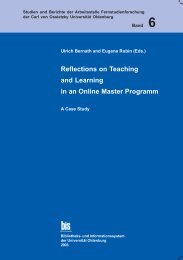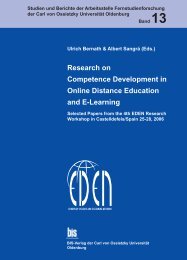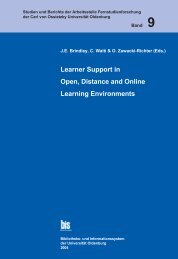Distance Education in Transition - Master of Distance Education ...
Distance Education in Transition - Master of Distance Education ...
Distance Education in Transition - Master of Distance Education ...
You also want an ePaper? Increase the reach of your titles
YUMPU automatically turns print PDFs into web optimized ePapers that Google loves.
The Pedagogical Flexibility <strong>of</strong> the Virtual University<br />
them. And the rema<strong>in</strong>der are prepared to attend courses to acquire computer competency,<br />
but have to be “bribed” and “motivated” by the university with USD 2 000 per year to do so.<br />
Internet Universities<br />
These are commercial enterprises which systematically <strong>in</strong>form potential students about<br />
the availability <strong>of</strong> onl<strong>in</strong>e degree courses <strong>of</strong>fered by universities throughout the USA and<br />
facilitate their enrolment at these universities. In other words, they are not engaged <strong>in</strong><br />
research, do not teach and do not confer degrees. They limit themselves to perform<strong>in</strong>g<br />
the function <strong>of</strong> educational brokers.<br />
� The Internet-University <strong>in</strong> Cambridge, MA.<br />
This university was founded <strong>in</strong> 1996 and uses the net to establish l<strong>in</strong>ks between potential<br />
students, most <strong>of</strong> whom are work<strong>in</strong>g adults, and those degree courses which would suit<br />
their needs, educational background and vocational experiences. The ma<strong>in</strong> functions <strong>of</strong><br />
this <strong>in</strong>stitution can be expla<strong>in</strong>ed by mention<strong>in</strong>g that it operates three search eng<strong>in</strong>es:<br />
(1) “F<strong>in</strong>d a course”, (2) “Search by school”, and (3) “Search by degrees”. Its educational<br />
relevance derives from its success <strong>in</strong> attract<strong>in</strong>g students. In 1996 there were 27 co-operat<strong>in</strong>g<br />
universities <strong>of</strong>fer<strong>in</strong>g 705 courses. Just three years later there were 124 co-operat<strong>in</strong>g<br />
universities <strong>of</strong>fer<strong>in</strong>g 3 878 courses (Ritter, 1999, p. 103). Obviously, there is an enormously<br />
grow<strong>in</strong>g demand for onl<strong>in</strong>e degree courses <strong>in</strong> this country. In fact, the number <strong>of</strong> students<br />
can be estimated at about 50 000 (Ritter, 1999, p. 103). This <strong>in</strong>stitution functions as a<br />
“virtual super-university” or “virtual meta-university” which comb<strong>in</strong>es and concentrates<br />
on the teach<strong>in</strong>g power <strong>of</strong> a large number <strong>of</strong> universities.<br />
� Western Governors Virtual University<br />
This <strong>in</strong>stitution is called “the nation’s first exclusively virtual university”, but <strong>in</strong> reality<br />
it is only an electronic clear<strong>in</strong>g house for promot<strong>in</strong>g <strong>in</strong>terstate exchanges <strong>of</strong> net-based<br />
courses. It was established <strong>in</strong> 1997 by a consortium <strong>of</strong> 18 western US states and 13<br />
larger <strong>in</strong>dustrial corporations. In the first place its task is to serve as platform for<br />
counsell<strong>in</strong>g students and broker<strong>in</strong>g courses from other universities. At present, 375<br />
certificate and 55 degree courses are provided. In addition, this <strong>in</strong>stitution is also a real<br />
private, non-pr<strong>of</strong>it university with the privilege <strong>of</strong> provid<strong>in</strong>g courses and conferr<strong>in</strong>g its<br />
own degrees. However, only 100 students have enrolled so far.<br />
Virtual Universities<br />
Morten Flate Paulsen (2000, p. 61) made an “International Analysis <strong>of</strong> Web-based<br />
<strong>Education</strong>” commissioned by the European Community as part <strong>of</strong> the European Leonardo<br />
da V<strong>in</strong>ci Programme. Paulsen analysed 130 <strong>in</strong>stitutions provid<strong>in</strong>g onl<strong>in</strong>e courses. Although<br />
there were seven universities among them that use the terms »virtual university« or<br />
»onl<strong>in</strong>e university« as part <strong>of</strong> their name, none <strong>of</strong> them was really a virtual university.<br />
In these cases, virtual university is a bombastic term which <strong>in</strong>dicates only that a<br />
pr<strong>of</strong>essor, or a teach<strong>in</strong>g unit, has started to go digital. In most <strong>of</strong> these cases the net is<br />
used only for perform<strong>in</strong>g or mediat<strong>in</strong>g a limited number <strong>of</strong> pedagogical functions.<br />
Obviously, the use <strong>of</strong> the term »virtual university« is mislead<strong>in</strong>g here.<br />
When a conventional university beg<strong>in</strong>s to transform <strong>in</strong>to a net-based university it<br />
certa<strong>in</strong>ly benefits from an academic <strong>in</strong>frastructure which has stood the test <strong>of</strong> time. This<br />
means that there is an organic <strong>in</strong>tegration <strong>of</strong> scientific research, academic teach<strong>in</strong>g and a<br />
188





